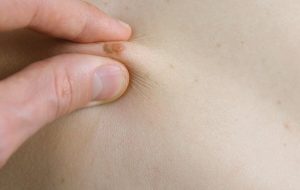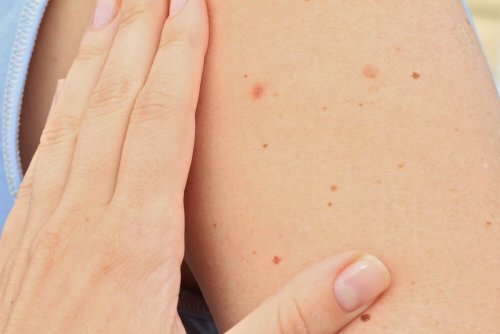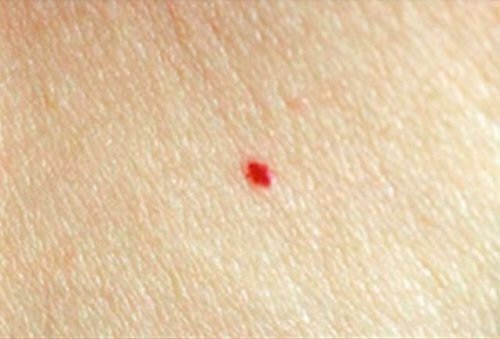Types of Moles and How to Identify Them

Moles, or according to their scientific name melanocytic nevus, are spots on the skin with different tonalities and forms that are present in all human beings. As their shape and color usually vary, it’s important for you to differentiate between the types of moles because not all of them are benign.
It’s estimated that at birth, children have an average of 10 moles on their skin, which is relatively low. People with whiter complexions are more susceptible to have these spots.
These moles can grow, change, or even disappear. It all depends on the care provided, genetic factors, and the changes in your health. This is because, theoretically, moles are alterations in your tissues.
With these considerations in mind, we’ll provide a list of the different types of moles and how to identify them. This way you can take care of your child’s skin from an early age. You can also instruct him or her to let you know of any change or particularity observed.
Types of moles: how to identify them
There are several concerns you should know about moles before you evaluate their physical characteristics. Healthy moles or common nevi are asymptomatic. This means that they shouldn’t cause itching, burning, oozing, or swelling; nor does the skin around them turn red or pale.
These are the first descriptions of what having a healthy mole entails. They can give you an idea of how to identify if there is an abnormality in your child’s skin. Now let’s focus on shape and color.
Shape
Moles have a circular appearance with very defined edges, though they can also have an oval shape. The diameter doesn’t exceed 5 millimeters in width and the estimated maximum size is similar to a pencil eraser.

There are two types of moles according to their shape: smooth, which are usually the most recurrent, and also those with elevation. By popular tradition, it’s considered that if a mole presents a palpable surface or grows, it can mask a melanoma or some other problem. This consideration isn’t true at all.
However, when it comes to mole abnormalities, irregular shapes can come up. That’s why you’ll need to see a dermatologist who can determine its true nature.
Moles shouldn’t be removed or touched in any way unless they itch, sting, or ooze. In any case, it’ll be the specialist in an outpatient intervention who must perform the process.
“At birth, children have an average of ten moles on their skin, which is relatively low.”
Color
In regards to color, they’re usually within a range of brown tones, but there are also black, blue, and red moles, such as the so-called cherry angiomas.
Mole color can also be an indication of alterations. However, as we previously mentioned about shapes, there’s nothing to fear if it’s asymptomatic, in theory.
A person’s skin tone will also have a close relationship with mole color. It has been identified that Caucasians and blonde people have moles with shades between pink and light brown. Meanwhile, people with dark hair or dark complexions have dark brown and black nevi.

How to identify abnormalities
It’s very rare for a healthy mole to turn into melanoma; there must be exceptional conditions for this to happen.
It’s also true that certain individuals are more prone to suffer from this condition, specifically those with very pale skin, people who expose themselves to the sun without protection, or those who have more than 50 moles.
It’s important to note that even though it’s good to identify if there are changes or alterations in your child’s moles, only a dermatologist will have the ability to determine the exact condition of the mole and the type of care it deserves.
If your child has more than ten on the skin, take her/him to a routine checkup with the specialist doctor to provide proper guidance on this subject.
In conclusion, it’s worth noting that in most cases, moles in children are benign. However, changes and alterations are directly related to indiscriminate and unprotected exposure to the sun. Prevention and skin care will always be excellent allies for children to have healthy skin.
Moles, or according to their scientific name melanocytic nevus, are spots on the skin with different tonalities and forms that are present in all human beings. As their shape and color usually vary, it’s important for you to differentiate between the types of moles because not all of them are benign.
It’s estimated that at birth, children have an average of 10 moles on their skin, which is relatively low. People with whiter complexions are more susceptible to have these spots.
These moles can grow, change, or even disappear. It all depends on the care provided, genetic factors, and the changes in your health. This is because, theoretically, moles are alterations in your tissues.
With these considerations in mind, we’ll provide a list of the different types of moles and how to identify them. This way you can take care of your child’s skin from an early age. You can also instruct him or her to let you know of any change or particularity observed.
Types of moles: how to identify them
There are several concerns you should know about moles before you evaluate their physical characteristics. Healthy moles or common nevi are asymptomatic. This means that they shouldn’t cause itching, burning, oozing, or swelling; nor does the skin around them turn red or pale.
These are the first descriptions of what having a healthy mole entails. They can give you an idea of how to identify if there is an abnormality in your child’s skin. Now let’s focus on shape and color.
Shape
Moles have a circular appearance with very defined edges, though they can also have an oval shape. The diameter doesn’t exceed 5 millimeters in width and the estimated maximum size is similar to a pencil eraser.

There are two types of moles according to their shape: smooth, which are usually the most recurrent, and also those with elevation. By popular tradition, it’s considered that if a mole presents a palpable surface or grows, it can mask a melanoma or some other problem. This consideration isn’t true at all.
However, when it comes to mole abnormalities, irregular shapes can come up. That’s why you’ll need to see a dermatologist who can determine its true nature.
Moles shouldn’t be removed or touched in any way unless they itch, sting, or ooze. In any case, it’ll be the specialist in an outpatient intervention who must perform the process.
“At birth, children have an average of ten moles on their skin, which is relatively low.”
Color
In regards to color, they’re usually within a range of brown tones, but there are also black, blue, and red moles, such as the so-called cherry angiomas.
Mole color can also be an indication of alterations. However, as we previously mentioned about shapes, there’s nothing to fear if it’s asymptomatic, in theory.
A person’s skin tone will also have a close relationship with mole color. It has been identified that Caucasians and blonde people have moles with shades between pink and light brown. Meanwhile, people with dark hair or dark complexions have dark brown and black nevi.

How to identify abnormalities
It’s very rare for a healthy mole to turn into melanoma; there must be exceptional conditions for this to happen.
It’s also true that certain individuals are more prone to suffer from this condition, specifically those with very pale skin, people who expose themselves to the sun without protection, or those who have more than 50 moles.
It’s important to note that even though it’s good to identify if there are changes or alterations in your child’s moles, only a dermatologist will have the ability to determine the exact condition of the mole and the type of care it deserves.
If your child has more than ten on the skin, take her/him to a routine checkup with the specialist doctor to provide proper guidance on this subject.
In conclusion, it’s worth noting that in most cases, moles in children are benign. However, changes and alterations are directly related to indiscriminate and unprotected exposure to the sun. Prevention and skin care will always be excellent allies for children to have healthy skin.
This text is provided for informational purposes only and does not replace consultation with a professional. If in doubt, consult your specialist.








